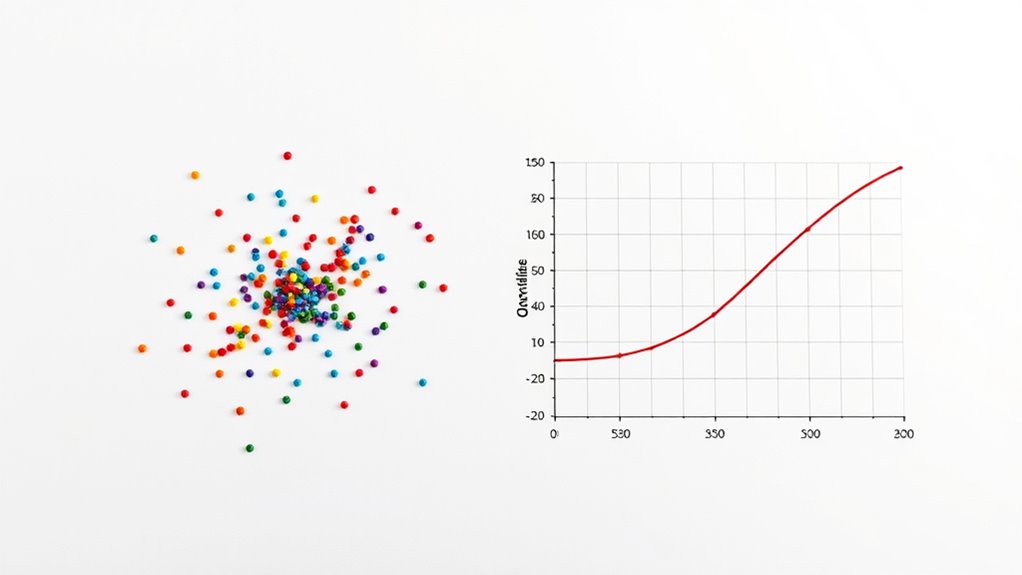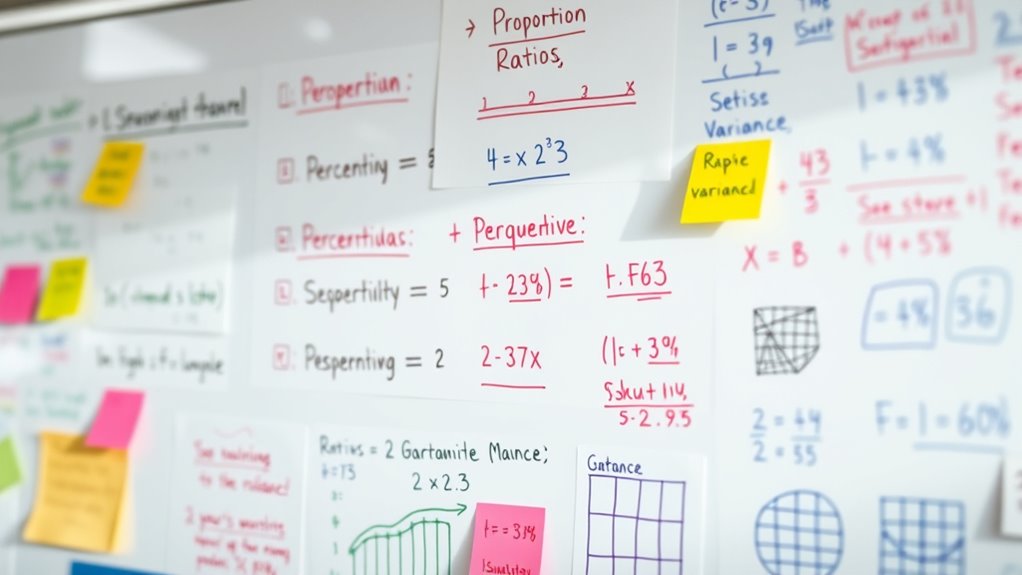To get started with statistics, focus on seven key formulas: calculating the mean to find the central value, measuring spread with variance and standard deviation, and identifying the median and mode for distribution insights. Percentiles and quartiles break down data into segments, while probability distributions help model different types of data. Understanding sample versus population parameters and proportions offers essential ratios. Keep exploring these formulas, and you’ll develop a stronger grasp of analyzing and interpreting data effectively.
Key Takeaways
- The mean formula calculates the average by dividing the sum of all data points by the total number of observations.
- Variance and standard deviation formulas measure data spread, with variance averaging squared differences from the mean.
- The median is found by sorting data and choosing the middle value, useful for skewed distributions.
- Percentiles and quartiles divide data into parts, with Q1, Q2, and Q3 indicating 25%, 50%, and 75% points respectively.
- Probability distribution formulas include PMF for discrete data, PDF for continuous data, and the CDF to find cumulative probabilities.
Understanding the Mean: The Central Tendency Formula

Understanding the mean is fundamental to grasping how data can be summarized with a single, representative value. The mean is calculated by adding all data points together and dividing by the total number of observations. The formula looks like this: ( (bar{x} = frac{sum x_i}{N}) ), where ( (x_i) ) represents each individual value, and ( (N) ) is how many data points there are. To find the mean, you simply sum all the data points, then divide by the count. Keep in mind that the mean is sensitive to outliers, which can pull it away from the true center of your data. Understanding this helps you interpret data accurately and choose the right measure for your analysis. Additionally, knowing about average calculations can improve your understanding of data distributions and statistical summaries. Recognizing the impact of outliers is crucial for proper data analysis and interpretation.
2. Measuring Spread With Variance and Standard Deviation

Measuring the spread of data is essential for understanding how individual values vary around the average. Variance shows this by calculating the average squared differences from the mean, with larger values indicating more variability. Efficient payment solutions can incorporate statistical measures like variance to monitor fluctuations in transaction volumes or values over time. Recognizing the importance of variance helps in selecting appropriate statistical tools for data analysis. To find the variance, you subtract the mean from each data point, square the result, and then average these squared differences—using (n) for populations or (n-1) for samples.
3. Calculating the Median and Mode for Distribution Insights

When analyzing data distributions, calculating the median and mode offers valuable insights into the dataset’s central tendencies and common patterns. The median is the middle value in a sorted dataset, giving you a typical central point. For even-numbered data, you average the two middle numbers. It’s especially useful when your data has outliers, as it remains unaffected by extreme values. Additionally, the median can help identify skewed distributions, providing a more accurate measure of central tendency in such cases.
The mode identifies the most frequently occurring value, helping you spot common patterns or preferences. In datasets with multiple modes, it reveals potential subgroups, while no mode indicates uniformity. Recognizing the benefits of mode can assist in understanding consumer behavior or preferences within a dataset. Both measures are versatile: the median helps with skewed or salary data, and the mode highlights popular categories like top-selling products. Together, they provide a clearer picture of your data’s distribution. Understanding statistical measures is essential for accurate data analysis and interpretation.
4. Percentiles and Quartiles: Breaking Down Data Distribution

Percentiles and quartiles are essential tools for breaking down data distribution, helping you see where individual data points stand relative to the entire dataset. Percentiles show the percentage of data below a specific value, highlighting outliers and extremes.
For example, the 25th, 50th, and 75th percentiles are known as quartiles, dividing data into four equal parts. Quartiles—Q1, Q2 (the median), and Q3—help visualize data spread and identify outliers.
To find them, you sort your data and locate the positions corresponding to these percentages. Visual tools like ogives plot cumulative frequency to estimate quartiles graphically.
5. Probability Distributions: Key Formulas for Modeling Data

Probability distributions are fundamental tools for modeling data and understanding the likelihood of different outcomes in various experiments. They describe how probabilities are spread across possible results, whether outcomes are discrete or continuous.
For discrete variables, you use the probability mass function (PMF), like in the binomial or Poisson distributions, which give the probability of specific outcomes.
For continuous variables, the probability density function (PDF) applies, such as in the normal or exponential distributions, showing the likelihood of values within a range.
The cumulative distribution function (CDF), (F(x) = P(X leq x)), helps you find the probability that a variable is less than or equal to a certain value.
Understanding the application of AI-generated music can also enhance your ability to model complex data using advanced statistical tools.
These formulas are essential for analyzing data, testing hypotheses, and building statistical models.
6. Sample vs. Population Parameters: When and How to Use Formulas

Understanding the difference between sample and population parameters is essential for accurate statistical analysis. You use population parameters, like the mean ((mu)) or standard deviation ((sigma)), when data from the entire population is available or necessary.
However, in most cases, collecting data from every individual isn’t practical, so you rely on sample statistics, such as the sample mean ((bar{x})) and sample standard deviation ((s)), to estimate these parameters. When working with smaller samples, it’s important to account for potential biases and variability, which can be addressed through techniques like sampling distribution analysis.
When dealing with large populations, sample statistics are more feasible and cost-effective. Remember, sample data introduces some error, known as sampling error, which affects the accuracy of your estimates. Additionally, understanding the difference between sample and population data helps you choose the appropriate formulas for your analysis. Knowing when to use each helps ensure your conclusions are both valid and reliable.
7. Proportions and Percentages: Essential Ratios and Their Variances

Proportions and percentages are fundamental concepts in statistics that help you compare parts of a whole and interpret data more intuitively. A proportion is a ratio like (frac{x}{y}), showing how one part relates to the whole, while a percentage scales that ratio to 100. To find a proportion, you solve the cross-product equation, such as checking if (frac{2}{16}) and (frac{5}{40}) are proportional. Percentages are used to express proportions as a value out of 100, making data easier to understand, like calculating 15% of 300. You can convert proportions to percentages by multiplying by 100. Both are crucial in analyzing data, comparing groups, and understanding trends across business, science, and finance. Understanding these concepts is also aided by knowing about vetted tools and resources, which can help clarify and apply statistical formulas effectively. Additionally, these ratios are essential in analyzing breakfast delivery trends and consumer preferences in the food industry.
Frequently Asked Questions
How Do I Choose Between Mean, Median, and Mode?
When choosing between mean, median, and mode, consider your data’s distribution and type.
If your data is symmetrical and continuous, the mean works well.
For skewed data or outliers, the median provides a better central value.
If you’re analyzing categories or most frequent values, the mode is ideal.
Think about what you want to learn—average, middle, or most common—and select the measure that best fits your data and goal.
What Is the Significance of the Standard Deviation in Data Analysis?
Standard deviation helps you understand data variability, showing how much individual data points differ from the average. When the deviation is low, your data is consistent; high deviation indicates more spread out data.
This insight aids in making informed decisions, evaluating risks, and understanding the reliability of results. It’s essential across fields like finance, quality control, and research, helping you interpret data patterns more accurately and confidently.
When Should I Use Population Versus Sample Formulas?
When deciding between population and sample formulas, consider whether you have data for the entire group or just a subset.
Use population formulas when you have complete data, ensuring precise results.
If you only have a sample, rely on sample formulas to estimate the whole population’s parameters.
Sampling is practical for large datasets, while population formulas give you exact metrics when data is fully available.
How Do I Interpret Percentile and Quartile Results?
Imagine revealing a hidden story within your data. When you interpret percentiles and quartiles, you discover where your data points sit relative to the whole.
A higher percentile means your value is among the top performers, while quartiles divide data into manageable sections, revealing spread and outliers.
Use these insights to compare datasets, identify trends, or spot unusual values, making your analysis more meaningful and nuanced.
What Is the Difference Between Variance and Standard Deviation?
You’re asking about the difference between variance and standard deviation. Variance measures how spread out data points are by averaging squared differences from the mean, giving a sense of overall dispersion.
Standard deviation, on the other hand, is the square root of variance, making it easier to interpret because it’s in the same units as your data. Both show variability, but standard deviation is more intuitive for understanding data consistency.
Conclusion
Mastering these formulas puts you in the driver’s seat of data analysis. With a clear grasp of concepts like mean, variance, and probability, you’re better equipped to navigate the data landscape. Think of these formulas as your keys to *accessing* insights hidden in numbers. Keep practicing, and you’ll find yourself crossing bridges from confusion to clarity—turning raw data into meaningful stories that drive decisions. The road to statistical confidence is just ahead!










